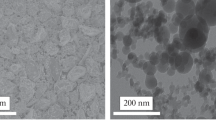The characteristics of superfine powder composites formed in the interaction of nanosized silicon carbide with iron oxide in vacuum and argon at 1200 and 1400°C, respectively, are analyzed. Silicon carbide (β-SiC), iron silicide and carbide, silicon oxide, and silicon oxynitride are main components of the powder composites. The lattice parameter of SiC in the powder composites synthesized in the SiC–Fe2O3 system is determined. In the interaction in the SiC–Fe2O3 powder mixture in vacuum, secondary SiC is synthesized with a lattice parameter that corresponds to the standard parameter for cubic β-SiC. The interaction in an argon atmosphere is accompanied by the synthesis of secondary SiC with a decreased lattice parameter. The minimum lattice parameter (0.4336 nm) is 0.6% smaller than the standard parameter for cubic β-SiC. The morphology of the powder composite synthesized in the SiC–Fe2O3 system is studied. The average particle size of the powder composite decreases with increasing weight content of secondary SiC.


Similar content being viewed by others
References
M.P. Gadzyra, G.G. Gnesin, and A.A. Mikhailik, “Segregation phenomena in powders of a nonequilibrium solid solution with excess carbon atoms substituting silicon atoms in the SiC lattice,” Sverkhtverd. Mater., No. 5, 56–64 (2001).
O.O. Mykhaylyk and M.P. Gadzira, “Arrangement of C atoms in the SiC–C solid solution,” Acta Crystallogr. B, 55, Part 3, 297–305 (1999), https://doi.org/10.1107/S0108768198013950.
N.I. Medvedeva, E.I. Yurieva, and A.L. Ivanovski, “Electron structure of cubic silicon carbide with 3d impurities in Si and C substitution sites,” Fiz. Tekh. Polyprov., 37, No. 11, 1281–1284 (2003).
F. Kawamura, H. Yamane, T. Yamada, Sh. Yin, and Ts. Sato, “Low-temperature fabrication of porous β- SiC ceramics in sodium vapor,” J. Am. Ceram. Soc., 91, No. 1, 51–55 (2008), https://doi.org/10.1111/j.1551-2916.2007.02021.x.
J. Chen, G. Yang, R. Wu, Y. Pan, J. Lin, R. Zhai, and L. Wu, “Large-scale synthesis and characterization of hexagonal prism-shaped SiC nanowires,” J. Nanosci. Nanotechnol., 8, No. 4, 2151–2156 (2008), https://doi.org/10.1166/jnn.2008.070.
F.-L. Wang, L.-Y. Zhang, and Y.-F. Zhang, “SiC nanowires synthesized by rapidly heating a mixture of SiO and arc-discharge plasma pretreated carbon black,” Nanoscale Res. Lett., 4, 153–156 (2009), https://doi.org/10.1007/s11671-008-9216-3.
G. Attolini, F. Rossi, M. Bosi, B.E. Watts, and G. Salviati, “Synthesis and characterization of 3C–SiC nanowires,” J. Non-Cryst. Solids, 354, No. 47–51, 5227–5229 (2008), https://doi.org/10.1016/j.jnoncrysol.2008.05.064.
H. Colder, R. Rizk, M. Morales, P. Marie, J. Vicens, and I. Vickridge, “Influence of substrate temperature on growth of nanocrystalline silicon carbide by reactive magnetron sputtering,” J. Appl. Phys., 98, No. 2, 024313-1–024313-10 (2005), https://doi.org/10.1063/1.1985975.
B.K. Dinistanova, M.A. Biysenbayev, T.A. Shabanova, S.Zh. Tokmoldin, and Z.A. Mansurov, “Studying the formation of silicon carbide nanotubes,” Izv. Nats. Akad. Nauk Rep. Kazakh., No. 6, 5–7 (2006).
M. Gadzira, G. Gnesin, O. Mykhaylyk, and O. Andreyev, “Synthesis and structural peculiarities of nonstoichiometric β-SiC,” Diam. Relat. Mater., 7, No. 10, 1466–1470 (1998), https://doi.org/10.1016/S0925-9635(98)00201-5.
Ya.G. Timoshenko and M.P. Gadzyra, “Phase formation and interaction between nanosized nonstoichiometric silicon carbide and iron oxide,” Powder Metall. Met Ceram., 51, No. 5–6, 295–300 (2012), https://doi.org/10.1007/s11106-012-9431-4.
G.G. Gnesin, Silicon Carbide Materials [in Russian], Moscow (1977), p. 216.
T.Ya. Kosolapova, T.V. Andreeeva, T.S. Bartnitska, G.G. Gnesin, G.N. Makarenko, I.I. Osipova, and E.V. Prilutski, Nonmetallic Refractory Compounds [in Russian], Moscow (1985), p. 224.
Author information
Authors and Affiliations
Corresponding author
Additional information
Translated from Poroshkova Metallurgiya, Vol. 58, Nos. 9–10 (529), pp. 36–43, 2019.
Rights and permissions
About this article
Cite this article
Tymoshenko, Y., Gadzyra, M. & Davydchuk, N. Secondary Silicon Carbide Formed in the Interaction of Nanosized Silicon Carbide with Iron Oxide. Powder Metall Met Ceram 58, 523–528 (2020). https://doi.org/10.1007/s11106-020-00106-z
Received:
Published:
Issue Date:
DOI: https://doi.org/10.1007/s11106-020-00106-z




